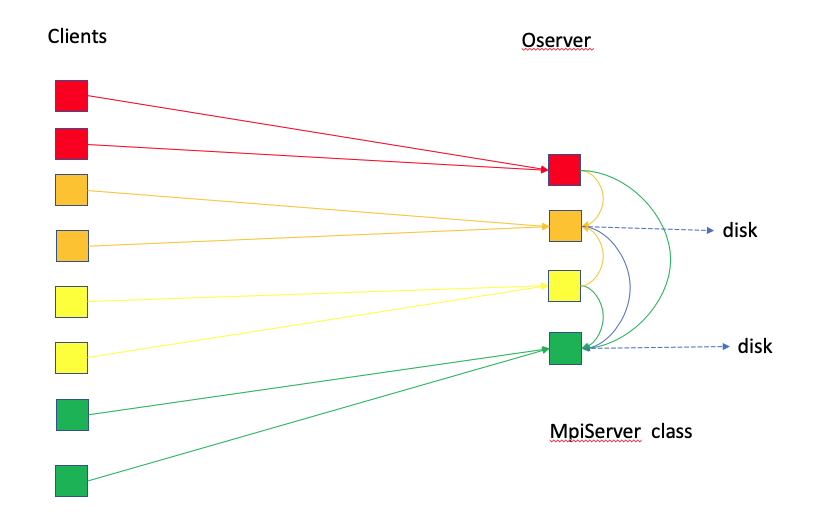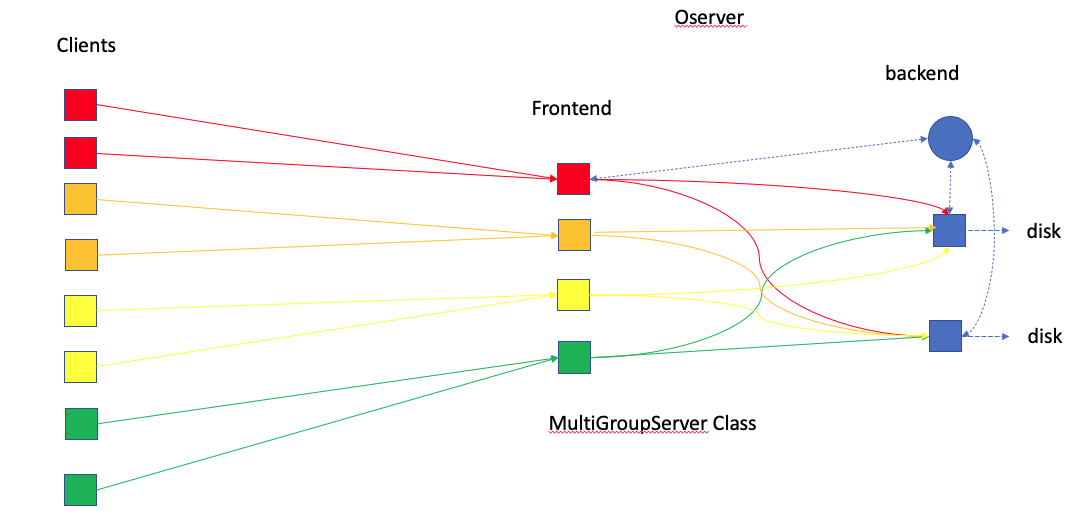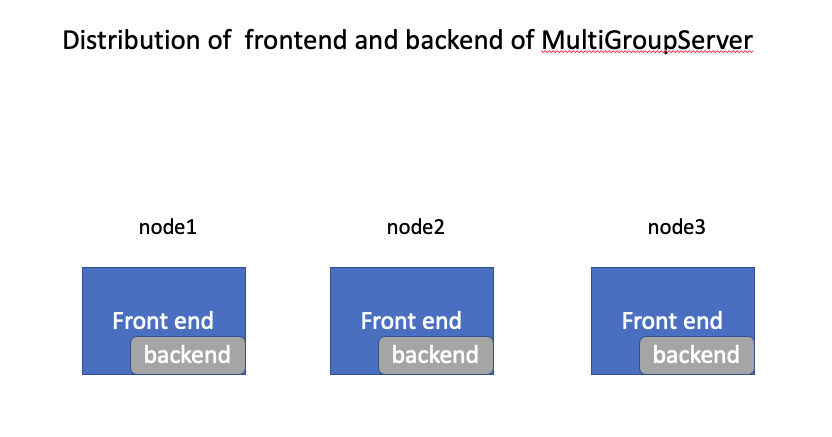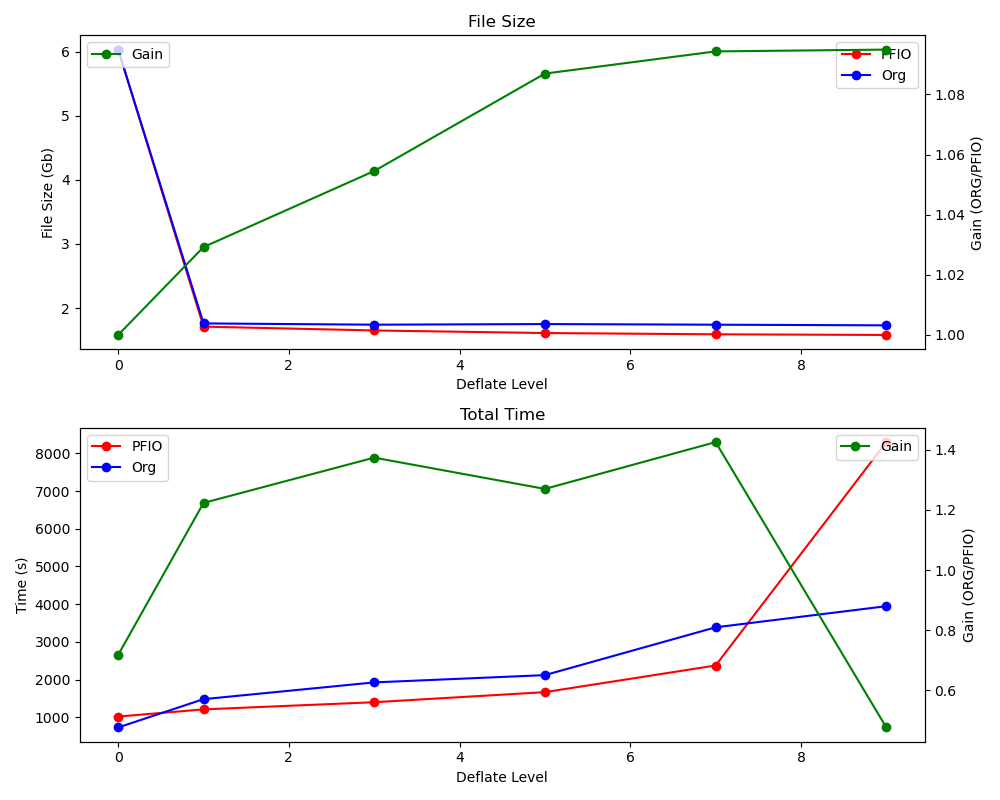PFIO: a High-Performance Client-Server I/O Layer
Introduction
GEOS-5 related applications (such as GEOSgcm, GEOSctm, GEOSldas, GCHP, etc.) produce a lot of outputs file that consist of several file collectinos that are created at different time frequencies.
As the model resolution increases, the amount of data produced significantly grows, exacerbating the file system specially if one processor is in charge of writing out all files.
PFIO, a subcomponent of the MAPL package was designed to facilitate the productions of model output files (organized in collections) in a distributed computing environment. PFIO asynchonically creates output files therfore allowing the model to proceed with calculations without waiting for the I/O to be completed. This leads to a decrease of the overall model integration time.
In the context of GEOS-5, the available nodes (cores) are split into two groups:
- The computing nodes that are reserved for model calculations
- The I/O nodes that are grouped to form the PFIO Server
All the file collections to be generated by the MAPL HISTORY (MAPL_History) subcomponent, are routed through the PFIO server that will distribute the output files to the I/O nodes (based on the user's configuration set at run time).
One of the features of PFIO is that it can be set to run the standard Message Passing Interface (MPI) root processor configuration.
This can be important if the model is integrated at low resolution and/or rgenerates a few file collections.
In this document, we explain how and when to configure the PFIO Server to run on separate resources. We also provide general recommendations on how to properly configure the PFIO Server in order to get the best possible performance. It is important to note that it is up to users to run their application multiple times to determine the optimal PFIO Server configuration.
MpiServer Class
- The clients sends the data to
Oserver. - All processors in
Oserverwould coordinate to create different shared memory windows for different collections. - The processors use one-sided
MPI_PUTto send the data to the shared memory. - Different collections are written by different processors. Those writing processors are distributed among nodes as eveny as possible.
- All the other processors have to wait for the wrting processors to finish jobs before responding to Clients’ next round of requests.
MultiGroupServer Class
- The oserver is devided into frontend and backend.
- When the frontend receive the data, its root process asks backend‘s root (or head) for an idle process for each collection<. Then it broadcasts the info to the other frontend processes.
- When the frontend processors forward (
MPI_SEND) the data to the backend ( different collections to different backend processors), they get back to the clients without waiting for the actual writing.
Command Line
There are two options to submit an executable through the mpi_run or mpi_exec command.
Regular MPI Command
If the regular mpirun or mpiexec command is used:
mpirun -np npes ExeccuTable
the MpiServer is used as oserver.
The client processes are overlapping with oserver processes.
The client and oserver are sequetically working together.
When client sends data, it actually makes a copy, then the oserver takes over the work,
i.e., shuffling data and writing data to the disk. After MpiServer is done, the client moves on.
Command with IOserver Options
n1 processes for the model and n2 processes for the MpiServer
mpirun -np npes ExeccuTable –npes_model n1 --npes_output_server n2
- Note that
$npes$ is not necessary equal to$n1+n2$ . - The
client(model) will use the minimum number of nodes that contain$n1$ cores.- For example, if each node has
nprocessors, then$npes = \lceil \frac{n1}{n} \rceil \times n + n$ .
- For example, if each node has
- If
--isolate_nodesis set to false (by default, it is true), theoserverandclientcan co-exist in the same node, and$npes = n1 + n2$ . -
--npes_output_server n2can be replaced by--nodes_output_server n2. Then the$npes = \lceil \frac{n1}{n} \rceil \times n + n2 \times n$ .
n1 processes for the model and n2 processes for the MultiGroupServer
mpirun -np npes ExeccuTable –npes_model n1 --npes_output_server n2 --oserver_type multigroup --npes_backend_pernode n3
- For each node of oserver,
$n3$ processes are used as backend. - For example, if each node has
$n$ cores, then$npes = \lceil \frac{n1}{n} \rceil \times n + n2 \times n$ . - The frontend has
$n2 \times (n-n3)$ processes and the backend has$n3 \times n$ processes. - The frontend has
$\lceil \frac{n2}{n} \rceil \times (n-n3)$ processes and the backend has$n3 \times n$ processes.
Passing a vector of oservers
mpirun -np npes ExeccuTable –npes_model n1 --npes_output_server n2 n3 n4
- The command creates
$n2$ -node,$n3$ -nodes and$n4$ -nodesMpiServer. - The
oserversare independent. The client would take turns to send data to differentoservers. - If each node has
$n$ processors, then$npes = \lceil \frac{n1}{n} \rceil \times n + (n2+n3+n4) \times n$ . -
Advantage: Since the
oserversare independent, theclienthas the choice to send the data to the idleoserver. -
Disavantage: Finding an idle
oserveris not easy.
Passing a vector of oservers and the MultiGroupServer
mpirun -np npes ExeccuTable –npes_model n1 --npes_output_server n2 n3 n4 --oserver_type multigroup --npes_backend_pernode n5
- The command creates
$n2$ -node,$n3$ -nodes and$n4$ -nodesMultiGroupServer. - The
oserversare independent. Theclientwould take turns to send data to differentoservers. - If each node has
$n$ processors, then$npes = \lceil \frac{n1}{n} \rceil \times n + (n2+n3+n4) \times n$ . - Each
oserverhas$n2 \times n5$ ,$n3 \times n5$ , and$n4 \times n5$ backend processes respectively.
MpiServer using one-sided MPI_PUT and shared memory
mpirun -np npes ExeccuTable –npes_model n1 --npes_output_server n2 --one_node_output true
- The option
--one_node_output truemakes it easy to createn2oservers and each is one-node oserver. - It is equivalent to
--nodes_output_server 1 1 1 1 1 ...withn2“1”s.
Additional Options
--fast_oclient true
- After the client sends history data to the oserver, by default it waits and makes sure all the data is sent even it uses non-blocking isend. If this option is set to true, the client copies the data before non-blocking isend. It waits and cleans up the copies next time when it re-uses the oserver.
Example
The file pfio_MAPL_demo.F90 is a standalone program that implement the use of PFIO.
It writes several time records of 2D and 3D arrays.
The compilation of the program generates the executable, pfio_MAPL_demo.x.
If we reserve 2 haswell nodes (28 cores in each), run the model on 28 cores and use 1 MultiGroup with 5 backend processes, then the execution command is:
mpiexec -np 56 pfio_MAPL_demo.x --npes_model 28 --oserver_type multigroup --nodes_output_server 1 --npes_backend_pernode 5
- The frontend has
$28-5=23$ processes and the backend has$5$ processes.
Performance Analysis
We create a collection that contains:
- one 2D variable (
IMxJM) - one 3D variable (
IMxJMxKM)
Three (3) 'daily' files are written out and each of them contains six (6) time records. We measure the time to perform the IO operations. Note that no calculations are involved here. We only do the array initialization.
PFIO has a profiling tool which is exercised by passing the command line option: --with_io_profiler true
mpiexec -np 56 $MAPLBIN/pfio_MAPL_demo.x --npes_model 28 --oserver_type multigroup --nodes_output_server 1 --npes_backend_pernode 5 --with_io_profiler true
It returns the following timing statistics:
- Inclusive: all time spent between start and stop of a given timer.
- Exclusive: all time spent between start and stop of a given timer _except_ time spent in any other timers.
o_server_front:--wait_message: Time while the front ends is waiting for the data from application.--add_Histcollection: Time for adding history collections.--receive_data: The total time Frontends receive data from applications.----collection_1: The time Frontends receive collection_1.--forward_data: The total time Frontends forward data to Backend.----collection_1: The time Frontends forward collection_1.--clean up: The time finalizing o-server.
IM=360 JM=181 KM=72
with 5 Backend PEs/node
=============
Name Inclusive % Incl Exclusive % Excl Max Excl Min Excl Max PE Min PE
i_server_client 0.324201 100.00 0.324201 100.00 0.520954 0.245613 0016 0023
Final profile
=============
Name Inclusive % Incl Exclusive % Excl Max Excl Min Excl Max PE Min PE
o_server_front 0.357244 100.00 0.053738 15.04 0.881602 0.013470 0000 0002
--wait_message 0.047207 13.21 0.047207 13.21 0.052244 0.040038 0011 0013
--add_Histcollection 0.003346 0.94 0.003346 0.94 0.005641 0.000294 0002 0007
--receive_data 0.194778 54.52 0.000496 0.14 0.000696 0.000367 0013 0019
----collection_1 0.194282 54.38 0.194282 54.38 0.421234 0.113870 0013 0021
--forward_data 0.057849 16.19 0.017939 5.02 0.051281 0.000058 0020 0018
----collection_1 0.039910 11.17 0.039910 11.17 0.048129 0.030721 0018 0019
--clean up 0.000325 0.09 0.000325 0.09 0.000529 0.000244 0009 0017
In the table below, we report the Inclusive time for the two main IO components as the number of backend PEs per node varies:
| Number of Backend PEs/node | i_server_client | o_server_front |
|---|---|---|
| 1 | ||
| 2 | 1.186932 | 1.813097 |
| 3 | 0.291334 | 1.216281 |
| 4 | 0.259511 | 0.296956 |
| 5 | 0.324201 | 0.357244 |
IM=720 JM=361 KM=72
with 5 Backend PEs/node
=============
Name Inclusive % Incl Exclusive % Excl Max Excl Min Excl Max PE Min PE
i_server_client 1.050624 100.00 1.050624 100.00 1.515223 0.822786 0015 0025
Final profile
=============
Name Inclusive % Incl Exclusive % Excl Max Excl Min Excl Max PE Min PE
o_server_front 1.250806 100.00 0.128693 10.29 2.737311 0.008478 0000 0012
--wait_message 0.108261 8.66 0.108261 8.66 0.130712 0.081595 0008 0022
--add_Histcollection 0.003061 0.24 0.003061 0.24 0.004589 0.001020 0004 0002
--receive_data 0.789012 63.08 0.000642 0.05 0.000909 0.000484 0013 0019
----collection_1 0.788370 63.03 0.788370 63.03 1.568300 0.406615 0013 0021
--forward_data 0.221412 17.70 0.102570 8.20 0.378546 0.000081 0021 0018
----collection_1 0.118842 9.50 0.118842 9.50 0.145169 0.090811 0013 0021
--clean up 0.000367 0.03 0.000367 0.03 0.000552 0.000256 0004 0012
In the table below, we report the Inclusive time for the two main IO components as the number of backend PEs per node varies:
| Number of Backend PEs/node | i_server_client | o_server_front |
|---|---|---|
| 1 | ||
| 2 | 3.378511 | 5.795466 |
| 3 | 0.977153 | 6.262224 |
| 4 | 1.009190 | 1.203735 |
| 5 | 1.050624 | 1.250806 |
Implementation of PFIO in LIS
PFIO was added to the LIS code as a library.
A new file, LIS_PFIO_HistoryMod.F90 was created to include PFIO related calls to produce LIS HISTORY.
PFIO offers the option (see the above section) to run the code using either the standard mpirun command or an IO server (reserved for producing HISTORY only).
Because the LIS code only has one collection (one HISTORY file), only one output server node (with any number of backend cores) is needed to use PFIO. Basically, we will have the command (assuming that we have 28 cores per node):
set num_cores_per_node = 28
set tot_npes = 224
@ comp_npes = ${tot_npes} - ${num_cores_per_node}
mpiexec -n $tot_npes $EXE --npes_model $comp_npes --oserver_type multigroup --nodes_output_server 1 --npes_backend_pernode 2
Therefore, there is only one command line configuration when PFIO is used in LIS.
For PFIO to be effective in LIS, we need at least two requirements:
- The process to produce the HISTORY files is signficantly more expensive than the calculations.
- The elapsed time between the full creation (writing into disk) two consecutive HISTORY files is less than the model integration time.
- If not, the ouput node might be continually oversubcribed.
- By principle in PFIO, the frontend processors (FPs) forward the data to the backend and they get back to the clients (compute processors) without waiting for the actual writing of the data. It is possible for the clients to send new requests to the FPs while the FPs are still sending data to the backend.
The LIS code does not have a profiler. In all the experiments we have done, we measure the total elapsed times. We plan to integrate a profiling tool in LIS that will allow us to better capture the time it takes to execute various components of the code.
Test Case
Model Configuration
- 5901x2801 grid points
- one-day integration with output produced every 3 hours (8 files with one record each)
- The fields to be written out are:
- 80 2D fields
- 4 3D fields (with 4 levels)
Without any data compression, each output file produced here requires 6.43 Gb. Our goal here is not only to reduce the time spent on IO but also to decrease the file size by applying data compression.
In all the experiment we did, the LIS/PFIO code produced bitwise identical results as the original version of the code.
Results with 112 Compute Cores
We ran the orginal version of the LIS code (ORG) and the one with the PFIO implementation (PFIO) using a
It is assumed that the PFIO option uses one additional node (reserved for output) with repected to the original version of the code.
| Deflation Level | Average File Size | Total Time (s) | ||
|---|---|---|---|---|
| ORG | PFIO | ORG | PFIO | |
| 0 | 6.43 | 6.43 | 734 | 1023 |
| 1 | 1.76 | 1.71 | 1484 | 1213 |
| 3 | 1.74 | 1.65 | 1928 | 1403 |
| 5 | 1.75 | 1.61 | 2121 | 1670 |
| 7 | 1.74 | 1.59 | 3388 | 2376 |
| 9 | 1.73 | 1.58 | 3948 | 8297 |
Results when the Number of Compute Cores Varies
We use the data compression level of 1 and let the number of compute cores varies. We record the total time for a one-day integration and the HISTORY file created every three hours.
| # Compute Cores | ORG | PFIO | Gain/Loss |
|---|---|---|---|
| 1484 | 1213 | +18% | |
| 1340 | 1198 | +11% | |
| 1292 | 1272 | +1.5% | |
| 1267 | 1374 | -8.4% |
As the number of computee cores increases, PFIO becomes less attractive. It is more likely due to the fact PFIO is not done before the model completes the calculations, therefore creation data congestion in the output server node.
Test Case 1
- 5901x2801 grid points
- Four-day integration with output produced every 1.5 hours (73 files with one record each)
- The fields to be written out are:
- 10 2D fields
- 2 3D fields (with 4 levels)
- Each file without data compression has a size of 412 Mb.
| 84 | 112 | 140 | 168 | 196 | 224 | 504 | 1008 | |
|---|---|---|---|---|---|---|---|---|
| Run Method | 817.88 | 614.58 | 491.55 | 410.19 | 350.77 | 307.14 | 137.03 | 68.35 |
| Output | 395.95 | 334.99 | 299.88 | 290.55 | 268.05 | 252.47 | 364.71 | 216.24 |
| Overall | 1495.24 | 1224.56 | 1062.53 | 968.48 | 889.67 | 825.61 | 687.49 | 555.93 |
Table 1.1 LIS: timiming statistics as the number of processors varies.
| # compute cores | # IO Nodes | Run Method | Output | Overall |
|---|---|---|---|---|
| 224 | 1 | 312.93 | 56.82 | 604.91 |
| 2 | 309.48 | 33.12 | 565.33 | |
| 504 | 1 | 137.37 | 942.47 | 1289.03 |
| 2 | 140.17 | 193.81 | 553.24 | |
| 3 | 139.95 | 78.22 | 425.78 | |
| 644 | 3 | 114.77 | 134.53 | 447.00 |
| 4 | ||||
| 784 | 3 | 89.97 | 284.14 | 574.70 |
| 4 | ||||
| 1008 | 4 | 69.97 | 217.53 | 495.42 |
| 5 | 70.01 | 135.00 | 397.69 |
Table 1.2 LIS/PFIO: timiming statistics as the number of compute processors and the number of IO node vary. In each case, we use 2 backend cores per IO nodes and set the number virtual output collections to be two times the number of IO nodes.
Test Case 2
- 5901x2801 grid points
- one-day integration with output produced every 1.5 hours (24 files with one record each)
- The fields to be written out are:
- 80 2D fields
- 4 3D fields (with 4 levels)
- Each file without compression has a size of 6.43 Gb.
| 84 | 112 | 140 | 168 | 196 | 224 | 1008 | |
|---|---|---|---|---|---|---|---|
| Run Method | 373.71 | 280.62 | 224.90 | 186.62 | 160.74 | 140.67 | 31.24 |
| Output | 1209.94 | 1229.54 | 1194.51 | 1228.61 | 1436.07 | 1420.89 | 1331.73 |
| Overall | 2269.26 | 2171.23 | 2069.12 | 2059.28 | 2235.15 | 2188.14 | 2050.97 |
Table 2.1 LIS: timiming statistics as the number of processors varies.
| # compute cores | # IO Nodes | Run Method | Output | Overall |
|---|---|---|---|---|
| 224 | 2 | 143.93 | 1021.35 | 1963.34 |
| 3 | 144.25 | 535.86 | 1422.43 | |
| 504 | 2 | 64.10 | 2106.05 | 4799.04 |
| 3 | 64.07 | 1631.45 | 2358.15 | |
| 1008 | 6 | 31.81 | 1341.00 | 2270.67 |
| 8 | 31.81 | 603.19 | 1899.65 |
Table 2.2 LIS/PFIO: timiming statistics as the number of compute processors and the number of IO node vary. In each case, we use 2 backend cores per IO nodes and set the number virtual output collections to be two times the number of IO nodes.



